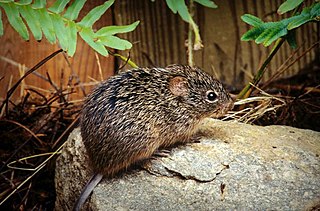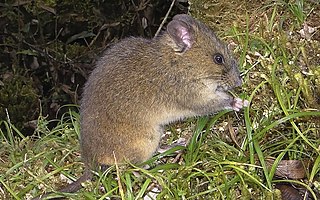
The rodent subfamily Sigmodontinae includes New World rats and mice, with at least 376 species. Many authorities include the Neotominae and Tylomyinae as part of a larger definition of Sigmodontinae. When those genera are included, the species count numbers at least 508. Their distribution includes much of the New World, but the genera are predominantly South American, such as brucies. They invaded South America from Central America as part of the Great American Interchange near the end of the Miocene, about 5 million years ago. Sigmodontines proceeded to diversify explosively in the formerly isolated continent. They inhabit many of the same ecological niches that the Murinae occupy in the Old World.
Cerradomys subflavus, also known as the terraced rice rat or flavescent oryzomys, is a rodent species from South America in the genus Cerradomys. It is found in the states of Goiás, São Paulo, and Minas Gerais, Brazil. Populations in Bolivia, Paraguay, and elsewhere in Brazil that were previously placed in this species are now classified as various other species of Cerradomys.
The lesser Wilfred's mouse is a species of South American rodents of the family Cricetidae. It was first described by Wilfred H. Osgood under the name Thomasomys pictipes, then into the genus Wilfredomys, and now known as Juliomys pictipes. The lesser Wilfred's mouse is endemic to northeastern Argentina and southeastern Brazil. Its physical appearance ranges from dark brown to light orange coloration and the typical size is small to medium. This species is arboreal, spending most of its time trees and living in the local forests at altitudes from sea level to 2000 m. Currently, this species is listed as Least Concern by the IUCN, but, threats include livestock farming, ranching, and wood harvesting.
Euryoryzomys legatus, also known as the Tarija oryzomys or big-headed rice rat, is a species of rodent in the family Cricetidae. It now belongs to the genus Euryoryzomys, having previously been placed in Oryzomys. It is found in the eastern Andes of northwestern Argentina and southern Bolivia.
Nephelomys levipes, also known as the nimble-footed oryzomys or light-footed rice rat, is a species of rodent in the genus Nephelomys of family Cricetidae. It is found on the eastern slope of the Andes from southeastern Peru into west-central Bolivia in cloud forest at elevations from 1,800 to 3,200 metres. It occurs in the same general area as its congener N. keaysi, but at higher altitudes.
Hylaeamys megacephalus, also known as Azara's broad-headed oryzomys or the large-headed rice rat, is a species of rodent in the genus Hylaeamys of family Cricetidae, of which it is the type species. It is found mainly in lowland tropical rainforest from its type locality in Paraguay north through central Brazil, French Guiana, Guyana, Suriname, and Venezuela onto Trinidad and Tobago. To its west and east, other closely related species of Hylaeamys are found: H. perenensis in western Amazonia, H. acritus in Bolivia, and H. laticeps and H. oniscus in the Atlantic Forest of eastern Brazil.

Thomasomys is a genus of rodent in the family Cricetidae, named after British zoologist Oldfield Thomas. Nuclear DNA sequence analysis has indicated that it is a sister taxon to Rhagomys. It contains the following species:
Daphne's Oldfield mouse is a species of rodent in the family Cricetidae. It is found in Bolivia and Peru.
Ladew's Oldfield mouse is a species of rodent in the family Cricetidae. It is found only in Bolivia.
The montane Oldfield mouse is a species of rodent in the family Cricetidae. It is found only in Bolivia.

Cerradomys is a genus of oryzomyine rodents from eastern Bolivia, Paraguay, and central Brazil found in cerrado, Caatinga and Gran Chaco habitats.
Cerradomys maracajuensis, also known as the Maracaju oryzomys, is a rodent species from South America. It is terrestrial and is found in gallery forests in Bolivia, Paraguay and nearby Brazil and Peru. It was first discovered near the Brazilian city of Maracaju.
Cerradomys scotti, also known as Lindbergh's oryzomys, is a rodent species from South America in the genus Cerradomys. It is terrestrial and is found in the cerrado (savanna) ecozone of south central Brazil, Bolivia and Paraguay. The species is common and appears to tolerate a degree of agricultural habitat modification.
The Apeco Oldfield mouse is a species of rodent in the family Cricetidae. It is known only from a single locality in north central Peru, which includes Rio Abiseo National Park, where it was found in cloud forest at an elevation of 3300 m. The species name comes from the acronym for the Asociacion Peruana para la Conservacion de la Naturaleza. It is among the largest members of the genus.

Thomasomys ucucha, also known as the ucucha thomasomys, is a rodent in the genus Thomasomys of the family Cricetidae. It is known only from high altitude forest and grassland habitats in the Cordillera Oriental of Ecuador. Seven other species of Thomasomys live in the same areas. First collected in 1903, T. ucucha was formally described as a new species in 2003 and most closely resembles T. hylophilus, which occurs further to the north. The species is listed as "vulnerable" in the IUCN Red List as a result of habitat destruction.
Hylaeamys acritus, formerly Oryzomys acritus, is an oryzomyine rodent of the family Cricetidae. The name is derived from the Greek word ακριτος 'confused, doubtful', because it could easily be confused with species such as H. megacephalus and Euryoryzomys nitidus. It is known only from northeastern Bolivia; its type locality is within Noel Kempff Mercado National Park. The rodent is terrestrial and is found in moist lowland semideciduous forest and savanna. It has olive brown coloration on its back; the cheeks and flanks are amber, and the top of the head is dark. The coat is 9 mm long at the center of the torso. Chest fur between the front legs is thick and 3 to 4 mm long. Abdominal hairs are gray at the base and white at the top.
Rhagomys is a genus of South American rodents in the tribe Thomasomyini of the family Cricetidae. Two species separated by about 3100 km are known, from southeast Peru and Bolivia east of the Andes, and in the Atlantic Forest of southeast Brazil. An undetermined species of Rhagomys has also been reported from Mato Grosso in central Brazil. The species are as follows:
Pardiñas’ Andean mouse is a species of sigmodontine rodent in the family Cricetidae known from the Cordillera del Cóndor and Cordillera de Kutukú, Ecuador. The species is named after Argentine palaeontologist Ulyses Pardiñas.

Burneo’s Oldfield mouse is a species of sigmodontine rodent in the family Cricetidae known from Sangay National Park in the eastern Andes, central Ecuador. The species is named after Ecuadorian mammalogist Santiago F. Burneo.
Antonio Brack's Oldfield mouse is a species of sigmodontine rodent in the family Cricetidae known from Peru. The species is named after Peruvian ecologist Antonio Brack Egg.





